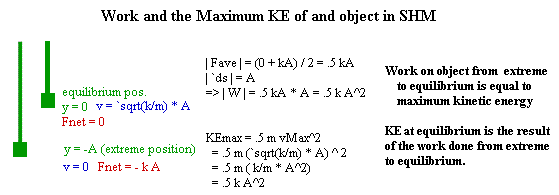Set 9 Problem number 6
Problem: If an object of mass 10 kilograms, suspended by a spring, is released from
rest at a point 6 meters below its equilibrium position, and if the spring has force
constant 10 Newtons/meter, then what will be its average kinetic energy between times t =
-.001 sec and t = .001 sec?
What is the average of the net forces on the object at the equilibrium point and at
distance A below equilibrium? Using this average, determine the work done on the object by
the spring between its release and the equilibrium position.
Comment in your summary on the relationship between your results and the conservation
of energy.
.
.
.
.
.
.
.
.
.
.
.
.
.
.
.
.
.
.
.
.
.
.
.
.
.
.
.
.
.
.
Solution: From the given information, we find that the angular velocity is
angular velocity = `sqrt(k/m) = `sqrt(k/m) = `sqrt[ 4 Newtons/meter) / ( 5 kilograms)]
= `sqrt( .8000 / sec ^ 2) = .8944 rad/sec.
{You are probably wondering where the the radian came from in that calculation. For now
you can probably get away with regarding the radian as a unit that appears when needed and
disappears when it doesn't belong. It is needed here, since it is part of the unit for
angular velocity}.
To determine the time required for a complete cycle, the model makes it clear that the
cycle will take place as the point makes one complete revolution, which requires 2 `pi rad
/ ( .8944 rad/sec) = 7.025 second.
Since the y coordinate will be 0 at the equilibrium position, the equilibrium position
will correspond to either of the times when the point on the circle crosses the x axis.
When the point passes through the positive x axis, the y coordinate is increasing, so the
object is moving upward. When the point passes through the negative x axis, the y
coordinate is going from positive to negative, which corresponds to downward motion. When
the object, which was originally pulled downward, first passes through the equilibrium
position it is moving upward. Since this happens when t = 0, we see that t = 0 when the
point is moving through the positive x axis.
At t = 4 sec, the angular position of the point on the circle (called the reference
point) is
ang. Pos. = `theta = `omega * t = .8944 radian / second ( 4 sec) = 3.577 radians.
This corresponds to a y position of 5 meters * SIN( 3.577 radians) = -.1085 meters.
At t = -.001 second, the angular position is
ang pos at -.001 sec = ( .8944 radian / second) (-.001 second) = -.0008944 radian,
resulting in a y position of
y(-.001 sec) = 5 meters * SIN( -.0008944 radian) = -.004472 meters.
A similar calculation for t = .001 second yields y position
y(.001 sec ) = .004472 meters.
Thus the y position changes by
`dy = .004472 meters - -.004472 meters = .008944 meters
in .002 seconds, for an average velocity of
vAve = `dy / `dt = 4.472 m/s. The object, having mass 5 kilograms, will therefore have
a kinetic energy of .5 ( 5 kg)( 4.472 m/s) ^ 2 = 49.99 Joules.
Generalized Response: The average velocity near the equilibrium point, as seen in
previous exercises, is near vAve = `sqrt(k/m) * A = `omega^2 * A. The KE near the
equilibrium point is therefore near
approx KE near equilibrium = .5 m v^2 = .5 m * (`sqrt(k/m) * A) ^ 2 = .5 k A^2.
The maximum net restoring force experienced is at the maximum displacement A from
equilibrium, and is
Fmax = k A.
The net force at the equilibrium point is zero, so the average force between
equilibrium and extreme has magnitude
|Fave| = (kA + 0) / 2 = .5 k A.
The distance through which the force acts, between equilibrium and extreme, is A, so
the work done has magnitude
| W | = | Fave | * A = .5 k A * A = .5 k A^2.
It is important to note that the expressions for KE and magnitude of work done are
identical.
.
.
.
.
.
.
.
.
.
.
Figure Description: The figure below depicts an object in SHM at its equilibrium and
extreme positions. The KE of the object and the net force on it are indicated at each
point. When the work done on the object from extreme to equilibrium is calculated from
average force and distance, the result is the same as the KE obtained from the mass and
velocity of the object at equilibrium. This is as expected. The work done between extreme
and equilibrium is the source of the KE at equilibrium.

